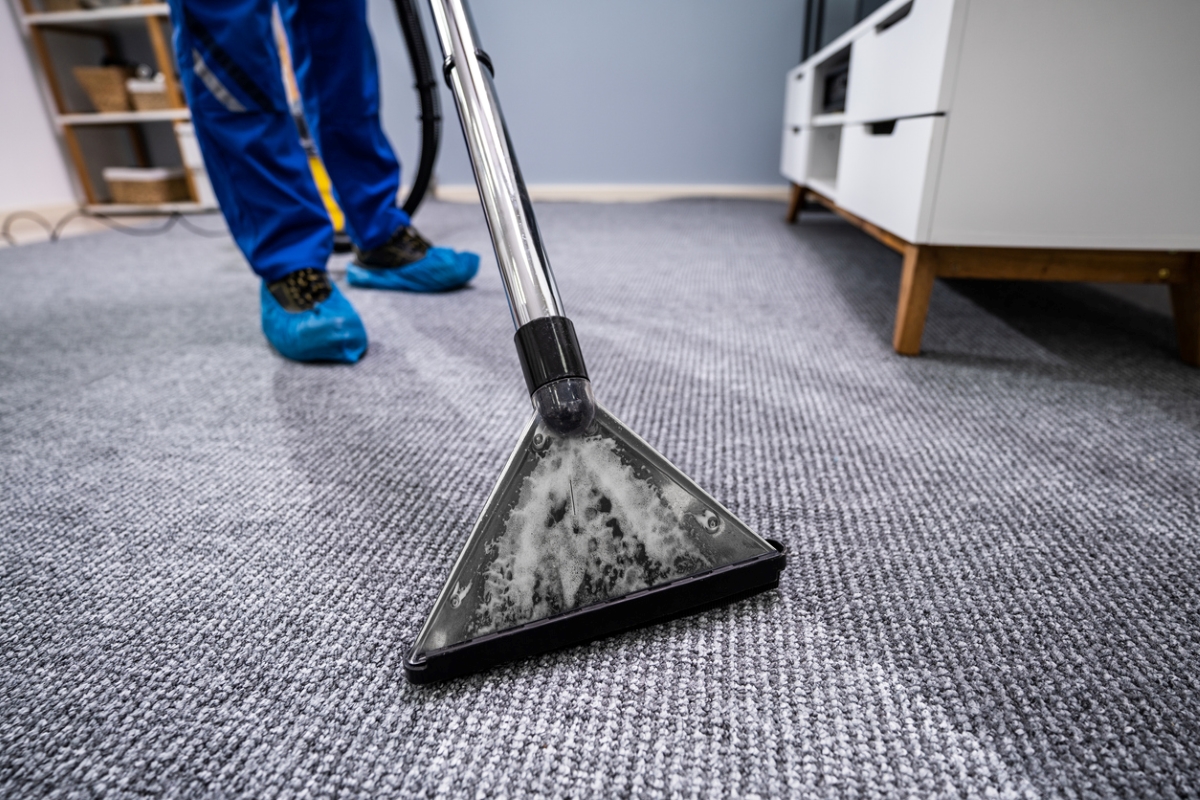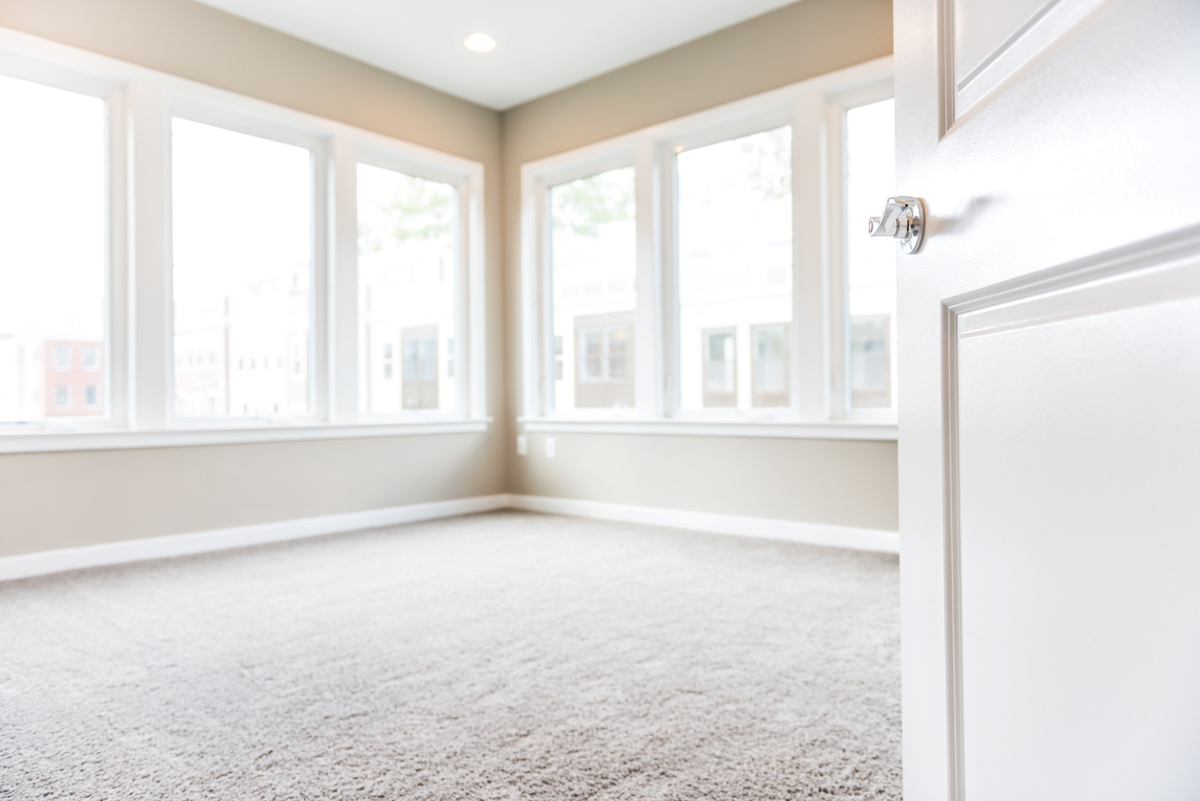

We may earn revenue from the products available on this page and participate in affiliate programs. Learn More ›
Q: My carpet is due for a cleaning, and I don’t want to move my furniture back onto it too early. Approximately how long does it take carpet to dry after cleaning? Also, are there any tricks to help reduce carpet cleaning dry time?
A: Everyday wear and tear on carpet—especially from pets and kids—introduces dirt, stains, discoloration, and odors that regular vacuuming can’t address. That’s why it’s recommended to thoroughly clean carpet at least once a year. Once the cleaning is complete, your carpet will remain damp for a while, so you’re right to wonder how long carpet takes to dry.
The not-so-simple answer is that it can take anywhere from 30 minutes to 72 hours for freshly cleaned carpet to dry—a wide span of time that depends on a variety of factors. These include how the carpet was cleaned, how dirty it was, what type of carpet it is, carpet pile, room size, ventilation, and even weather conditions.
Ahead, you’ll discover how various types of cleaning methods impact drying time, as well as how to dry wet carpet after a cleaning.
It depends on the cleaning method.
A number of carpet cleaning methods can be used to tackle troublesome stains and odors, and each dries a bit differently. Whether you choose an upright carpet cleaner or high-quality portable carpet cleaner, it is important to know how quickly each method dries and the best way to dry carpet after cleaning.
RELATED: 10 Homemade Carpet Cleaning Remedies
Shampooing
This method entails adding a deep-cleaning foaming cleanser, or shampoo, into a carpet extractor that uses hot water or steam combined with sucking power to clean carpet. The cleanser creates a frothy layer on top of the carpet that rotating brushes in the machine then work into the rug to clean it. The cleanser is then rinsed out with plain water. Shampooed carpet needs about 6 to 10 hours to dry. While this method works well for extra-dirty carpets, shampoo residue can be left behind that discolors the carpet and attracts dirt. Heavy-duty rug shampoo can be purchased, but you can also make your own with this homemade carpet shampoo recipe.

Steam Cleaning
Steam cleaning, or wet cleaning, uses detergent, very hot water that turns into steam, and pressure to clean carpet by drawing out grime. The water is then vacuumed up, but the carpet is nonetheless left quite wet. Steam cleaning is recommended for high-traffic areas and for homeowners who are sensitive to scents or have allergies since there is no smell or residue left on the carpet fibers. One disadvantage is that expensive, powerful equipment is needed for steam cleaning. The other issue is that because steam cleaners leave moisture, it can take longer for carpet to fully dry without any drying equipment: anywhere from 24 to 72 hours.
Encapsulation
This is a popular option because it only takes 1 to 2 hours to dry. Encapsulation involves a brush machine that applies a foam or liquid cleaning agent to the carpet, forming a powder. Dirt and debris become encapsulated within the powder, which is then vacuumed away. This process does not leave behind a residue, but it is not recommended for heavily stained carpet.
Dry Carpet Cleaning
Dry carpet cleaning is a low-moisture option that involves sprinkling dry or powder-based chemicals on the carpet, letting them sit for about 15 minutes, and then using a regular vacuum on the area. Although this technique does not provide a deep clean, it can remove odors, dirt, and debris. This is an attractive option since the drying time is so short. Because hardly any water is used, carpet will dry within 30 minutes to an hour with this approach. The negatives are that dry carpet cleaning is not as powerful as the other methods and this method can leave residue on the carpet that can trigger allergies and harm the carpet over time.
The type of carpet plays a factor in dry time.
Various types of carpet require different care methods, whether you are having wall-to-wall carpet professionally cleaned or trying to remove blood stains on your own. The material a carpet is produced from affects how quickly it dries after being cleaned, for example. Artificial materials like nylon and polyester dry much faster than natural materials like wool and cotton. Carpet made from polyester takes between 6 to12 hours to dry, but wool carpet takes at least 24 hours to dry.
The size and thickness of the carpet pile also plays a role in drying time. A plush carpet with a deep pile takes longer to dry than a carpet with a low pile—typically from 12 to 24 hours. A Berber carpet, which is made from low, densely packed, looped yarns, is more textured than plush. It absorbs less water and takes less time to dry after cleaning—between 6 and 12 hours.
Ambient conditions can affect how long it takes carpet to dry after cleaning.
Weather can put a damper on your carpet drying experience. Both temperature and humidity impact how long it takes for carpet to dry after it are cleaned. If it is rainy and humid outside, expect the carpet to take much longer to dry. On the other hand, if it is hot and sunny outside, carpet will most likely dry faster. If possible, try to avoid cleaning carpet during the coldest and wettest months of the year since it takes longer for carpet to dry in those conditions.
The indoor environment also plays a role. To help speed up evaporation and drying time, it is recommended to set the thermostat to 70 degrees Fahrenheit.

How to Dry Carpet Faster
It is crucial to make sure carpet fully dries after it is cleaned to prevent any mold or mildew growth. While wet carpet will eventually dry on its own, homeowners can speed up the process with these tricks that explain how to dry carpet fast.
RELATED: The Best Carpet Cleaning Companies, Vetted
Open windows and doors.
A simple solution is to open windows and doors in the home. This gets fresh air circulating throughout the carpeted rooms, which helps carpets dry and eliminates a musky odor. At a minimum, allow sunlight into the room by opening shades and curtains to speed up the drying process.
Run fans.
Help carpet dry more rapidly by turning on fans throughout the house, including ceiling fans, floor fans, and even bathroom vent fans. This can help improve the airflow and help carpet dry more quickly. Another option is to rent industrial floor fans or blowers to reduce drying time; make sure to point fans directly at the carpet. Using a couple of these high-powered items can dry each carpeted room in less than 30 minutes.
Use air conditioning.
An alternative to running fans is to turn on the air conditioning to get the air moving to remove excess moisture and help the carpets dry. This is a good option in warmer months when it might be uncomfortable to open windows and doors.
Turn up the heat.
While running the heat is the opposite of the previous tip, it is another effective option, especially in cooler months. Heat in the air leads to more evaporation, which helps the carpet dry. Turn up the heat to above 78 degrees Fahrenheit to help move the drying process along.
Try a dehumidifier.
Another great option is to plug in one or two dehumidifiers to reduce moisture, which in turn will help the carpet dry faster. Avoid running a dehumidifier while windows are open, however, since that will eliminate its effectiveness.
